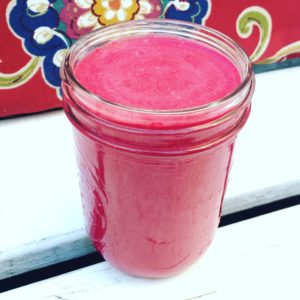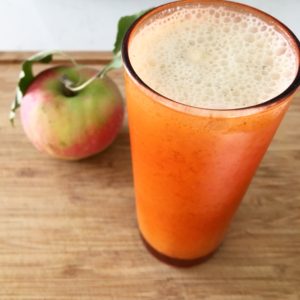I recently did a 3-week cleanse, eliminating all gluten, dairy, added-sugar (including alcohol) and caffeine from my diet. In the end, caffeine (or the lack there of) seemed to make the biggest impact on my mental and physical sense of well-being. It’s not that I was drinking 5+ cups of coffee a day–in fact, I rarely had more than one–but as someone who is admittedly type A and stress-prone, the stimulant effect of caffeine was doing more harm than good.
Without caffeine I fall asleep faster, wake up feeling more rested and have far fewer spikes in anxiety throughout the day.
That being said, I’m someone who loves a latte from time to time and while decaf espresso is better than regular, it still contains caffeine. Everything in moderation, I still intend to have my decaf almond milk latte’s from Whole Foods every now and again, but on a more regular basis I’ve devised a delicious caffeine-free alternative loaded with superfoods.
Here are the highlights of three nutrient-dense ingredients in my caffeine-free, vegan latte:
Chicory Root:
- detoxifying coffee-substitute
- naturally caffeine-free
- antimicrobial and antifungal properties
- phenolic antioxidants help reduce inflammation and prevent disease
The taste isn’t a dead ringer for coffee, but as someone who loves(/d) black coffee it comes pretty darn close.
Cinnamon
- regulates blood sugar
- reduces LDL cholesterol
- anti-inflammatory properties which reduce cytokines linked to arthritic pain
- reduces chronic inflammation linked with Alzheimer’s disease, Parkinson’s disease, multiple sclerosis, brain tumors and meningitis
- alleviates menstrual pain
- may be effective for infertility because it contains cinnamaldehyde, which studies show increases the hormone progesterone and decreases testosterone production in women
Coconut Oil
- contains lauric acid (a medium chain triglyceride or MCT) which increases the good HDL cholesterol in the blood to help improve cholesterol ratio levels
- rich in antioxidants, which helps boost immunity
- when MCT breaks down helps liver break down fats and increase metabolism
- may help regulate blood sugar and reduce abdominal fat
Chicory Almond Milk Latte
What You’ll Need:
{makes 2 servings}
- 1 Tbs chicory root tea
- 10-oz water
- 8-oz unsweetened almond milk (see recipe for my Homemade Almond Milk below)
- 2 medjool dates
- 2 tsp coconut oil
- 1/2 tsp cinnamon
- 1/4 tsp each ground cloves, nutmeg, cardamon and white pepper
How to Make It:
- Steep 1 tablespoon of roasted chicory root tea in 10-oz of boiling water for 3-5 minutes.
- In a blender, add 8-oz unsweetened almond milk, 2 medjool dates (pits removed), 2 teaspoons of coconut oil and all the spices.
- Once tea is steeped, add tea to blender and blend on high for 1 minute until frothy.
- Serve in two coffee mugs with a dash of cinnamon or cocoa powder on top.
Note: if you like your lattes extra hot, give this a nuke in the microwave for 30-40 seconds or heat your almond milk on the stovetop in advance of putting it in the blender.
Homemade Almond Milk
What You’ll Need:
- 1 cup raw almonds
- 4 cups filtered water
How to Make It:
- Add almonds and water to blender and mix on high until smooth.
- Optional: strain liquid through cheese cloth to remove any pith.
Note: You can also add 1 tsp of vanilla extract to make it an unsweetened vanilla almond milk.










